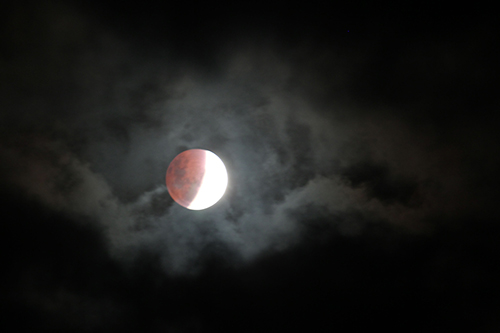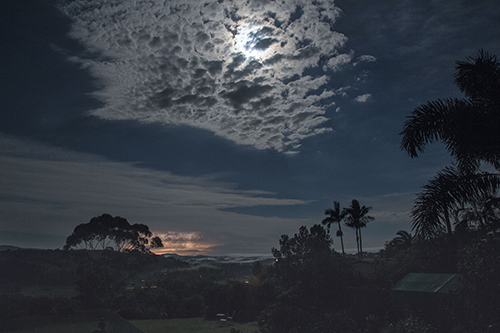On a clear night you can see forever, (with apologies to playwright Alan Jay Lerner)
For weeks the weather was dry and the sky cloudless, leading Northern Rivers residents, especially gardeners to believe - foolishly, of course - that it might never rain again.
Then, on the afternoon of 31 January 2018 the clouds built up and by dusk there was no sky to be seen. No sunset, and more importantly, no full moon starting to rise.
Amidst all the media hype, the local area, and a good deal of eastern Australia, would miss out on seeing what was billed a once in a lifetime event, a Super Blue Blood Moon.
With a desperate hope of glimpsing this rare event, the first total lunar eclipse since 2015, many locals stayed up, or roused themselves, at midnight, but to no avail.
Groans of disappointment, even anger, flooded social media, further fuelled by links to a host of websites where sky gazers posted stunning images of the Moon over the Pyramids, the mosques of Istanbul, and much of the USA (thank you Steve Scanlon from Locust, New Jersey who snapped the event at the civilised time of 6.53am).
If we felt let down, how devastated were the ardent astro-photographers who spend hours each week looking into space and recording the movements of the galaxies and planets that circulate above us?
GP Speak sought comment from Stephen Moore, consultant physician with visiting rights at Lismore Base Hospital. A long-time local resident, Stephen has built a backyard hill-top observatory with a 3,000 mm focal length telescope that makes the Moon, Jupiter and rest of them seem close enough to touch.
When you rely on the weather to behave you must be prepared for disappointment,” he told us from the confines of his observatory dome a week after the Moon, or more accurately the clouds, had let us down so badly.
“It was largely media-driven hype… though this is a good thing if it gets people looking up at the sky. The fact is that the next lunar eclipse will be just as good, and there are quite a lot of them. The next one is in the early hours of the morning on July 28.
“The great thing about lunar eclipses is that they’re a global occurrence. You don’t have to travel to see them, as distinct from solar eclipses that are only visible from certain places on earth.

For the record, the next total solar eclipse visible from Australia will be in 2028. Not content to wait, Stephen plans to travel with his wife Gabrielle to Chile in July 2019 where his adult boys will join them to witness the blacked-out Sun.
In August last year two of their sons (and one of mine) got the taste for solar eclipsing from the mid-north states of the USA, which provided an ideal view of the new Moon blocking out Earthlings’ view of sunlight. Festivals lasting well beyond the few minutes of darkness were planned around it.

Stephen Moore’s interest in the universe above dates from childhood in Canberra, a place that in those days had minimal light pollution to interfere with star-gazing. But his passion dates back to his 40th birthday when he gave himself a small telescope as a present.
He was hooked, although his advice to beginners is to start with a good set of binoculars - “It’s amazing what they can reveal, especially in an area like ours where the skies are so dark and clear - mostly, anyway!”
If you decided to pursue the interest further, you could follow in Stephen’s footsteps and undertake postgraduate study in astronomy. At the time of interview he was set to finish the last of 12 units in a Masters degree program offered by Swinburne University. The tutors, Stephen said, are well known on the world stage.
“I’ve been doing it for fun,” he added.

“It forced me to another level, studying the topics you would expect, the movements and inter-relationships of the planets and galaxies, and so on, but also things like archeoastronomy, which looks at places like Machu Picchu and Stonehenge.”
He has visited both sites and has superb photographs - in self-made frames - mounted on the walls of chez Moore.
While assignments for the course need not include night sky images - not everyone has a backyard observatory and high-level photographic skills - Stephen has delighted in including a range of images.
He uses a Canon 60da, a ‘cooled dedicated telescope camera’, and a planetary camera that produces bracketed, video-like images that can be stacked together to provide an enhanced shot.

As specialised as this may sound, neither the study program nor his ability behind the shutter equips him to be a professional astronomer - Lismore Base take heart.
“That’s a whole other level, involving PhDs and beyond, with access to the telescopic equipment at the observatories managed mostly by the main universities.
“I’m just an enthusiast, and that’s why it’s such fun. No pressure to make discoveries or have a star named after me.”
Asked whether evolutionary developments on Earth are being replicated in the heavens, Stephen says that even up there things are changing, if rather slowly.
“The Moon is slowly spinning away, and there will come a time when it will no longer completely block the Sun as seen from the Earth’s surface.”
Should we hold our breath?
“Probably not, it might take several million years.”

















